How to Read Phenol Red Broth Test
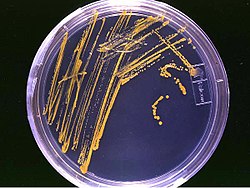
An agar plate – an example of a bacterial growth medium*: Specifically, it is a streak plate; the orange lines and dots are formed by bacterial colonies.
A growth medium or civilization medium is a solid, liquid, or semi-solid designed to support the growth of a population of microorganisms or cells via the process of cell proliferation[one] or pocket-sized plants similar the moss Physcomitrella patens.[two] Different types of media are used for growing dissimilar types of cells.[3]
The two major types of growth media are those used for prison cell civilisation, which utilise specific cell types derived from plants or animals, and those used for microbiological civilization, which are used for growing microorganisms such as bacteria or fungi. The most common growth media for microorganisms are nutrient broths and agar plates; specialized media are sometimes required for microorganism and cell civilisation growth.[one] Some organisms, termed captious organisms, crave specialized environments due to circuitous nutritional requirements. Viruses, for case, are obligate intracellular parasites and require a growth medium containing living cells.
Types [edit]


The nearly common growth media for microorganisms are nutrient broths (liquid nutrient medium) or lysogeny broth medium. Liquid media are ofttimes mixed with agar and poured via a sterile media dispenser into Petri dishes to solidify. These agar plates provide a solid medium on which microbes may exist cultured. They remain solid, as very few bacteria are able to decompose agar (the exception being some species in the genera: Cytophaga, Flavobacterium, Bacillus, Pseudomonas, and Alcaligenes). Bacteria grown in liquid cultures ofttimes course colloidal suspensions.[4] [5]
The difference betwixt growth media used for jail cell civilisation and those used for microbiological civilisation is that cells derived from whole organisms and grown in culture often cannot grow without the improver of, for instance, hormones or growth factors which usually occur in vivo.[vi] In the case of animal cells, this difficulty is oftentimes addressed by the improver of blood serum or a synthetic serum replacement to the medium. In the example of microorganisms, no such limitations exist, as they are often unicellular organisms. One other major departure is that brute cells in civilization are often grown on a flat surface to which they attach, and the medium is provided in a liquid form, which covers the cells. In dissimilarity, bacteria such as Escherichia coli may be grown on solid or in liquid media.
An important distinction between growth media types is that of defined versus undefined media.[i] A divers medium will have known quantities of all ingredients. For microorganisms, they consist of providing trace elements and vitamins required by the microbe and specially defined carbon and nitrogen sources. Glucose or glycerol are often used every bit carbon sources, and ammonium salts or nitrates every bit inorganic nitrogen sources. An undefined medium has some complex ingredients, such as yeast extract or casein hydrolysate, which consist of a mixture of many chemical species in unknown proportions. Undefined media are sometimes called based on toll and sometimes by necessity – some microorganisms have never been cultured on defined media.
A good example of a growth medium is the wort used to make beer. The wort contains all the nutrients required for yeast growth, and under anaerobic atmospheric condition, alcohol is produced. When the fermentation procedure is complete, the combination of medium and dormant microbes, now beer, is ready for consumption. The main types are
- cultural media
- minimal media
- selective media
- differential media
- transport media
- indicator media
Culture media [edit]
Culture media contain all the elements that well-nigh bacteria demand for growth and are not selective, and so they are used for the general cultivation and maintenance of bacteria kept in laboratory civilization collections.

An undefined medium (also known as a basal or circuitous medium) contains:
- a carbon source such as glucose
- water
- diverse salts
- a source of amino acids and nitrogen (eastward.g. beef, yeast extract)
This is an undefined medium considering the amino-acid source contains a variety of compounds; the exact composition is unknown.
A defined medium (also known as chemically defined medium or synthetic medium) is a medium in which
- all the chemicals used are known
- no yeast, animal, or plant tissue is present
Examples of nutrient media:
- nutrient agar
- plate count agar
- trypticase soy agar
Minimal media [edit]
A defined medium that has only enough ingredients to support growth is called a "minimal medium". The number of ingredients that must be added to a minimal medium varies enormously depending on which microorganism is being grown.[7] Minimal media are those that comprise the minimum nutrients possible for colony growth, by and large without the presence of amino acids, and are often used by microbiologists and geneticists to grow "wild-type" microorganisms. Minimal media can also be used to select for or against recombinants or exconjugants.
Minimal medium typically contains:
- a carbon source, which may be a saccharide such as glucose, or a less energy-rich source such equally succinate
- various salts, which may vary amongst bacteria species and growing conditions; these generally provide essential elements such equally magnesium, nitrogen, phosphorus, and sulfur to allow the bacteria to synthesize protein and nucleic acids
- water
Supplementary minimal media are minimal media that also contains a single selected agent, commonly an amino acrid or a sugar. This supplementation allows for the culturing of specific lines of auxotrophic recombinants.
Selective media [edit]
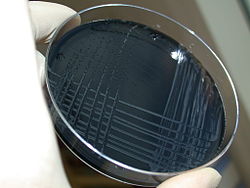
Blood-free, charcoal-based selective medium agar (CSM) for isolation of Campylobacter
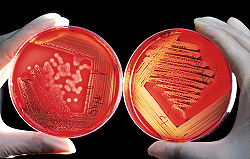
Blood agar plates are ofttimes used to diagnose infection. On the right is a positive Staphylococcus culture; on the left is a positive Streptococcus culture.
Selective media are used for the growth of only selected microorganisms. For example, if a microorganism is resistant to a certain antibiotic, such as ampicillin or tetracycline, so that antibiotic can be added to the medium to preclude other cells, which do non possess the resistance, from growing. Media lacking an amino acid such as proline in conjunction with East. coli unable to synthesize it were commonly used by geneticists earlier the emergence of genomics to map bacterial chromosomes.
Selective growth media are besides used in cell civilisation to ensure the survival or proliferation of cells with certain backdrop, such equally antibody resistance or the ability to synthesize a certain metabolite. Ordinarily, the presence of a specific factor or an allele of a gene confers upon the cell the ability to grow in the selective medium. In such cases, the gene is termed a marker.
Selective growth media for eukaryotic cells normally comprise neomycin to select cells that have been successfully transfected with a plasmid carrying the neomycin resistance gene as a mark. Gancyclovir is an exception to the rule, as information technology is used to specifically kill cells that conduct its respective marker, the Herpes simplex virus thymidine kinase.
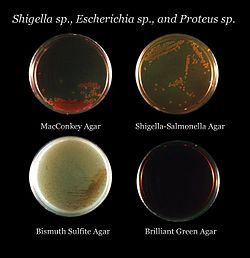
Four types of agar plate demonstrating differential growth depending on bacterial metabolism
Examples of selective media:
- Eosin methylene blue contains dyes that are toxic for Gram-positive bacteria. It is the selective and differential medium for coliforms.
- YM (yeast extract, malt extract agar) has a low pH, deterring bacterial growth.
- MacConkey agar is for Gram-negative bacteria.
- Hektoen enteric agar is selective for Gram-negative bacteria.
- HIS-selective medium is a blazon cell culture medium that lacks the amino acid histidine.
- Mannitol salt agar is selective for gram-positive leaner and differential for mannitol.
- Xylose lysine deoxycholate is selective for Gram-negative leaner.
- Buffered charcoal yeast excerpt agar is selective for certain gram-negative bacteria, particularly Legionella pneumophila.
- Baird–Parker agar is for gram-positive staphylococci.
- Sabouraud'southward agar is selective to certain fungi due to its low pH (5.six) and loftier glucose concentration (3–4%).
- DRBC (dichloran rose bengal chloramphenicol agar) is a selective medium for the enumeration of moulds and yeasts in foods. Dichloran and rose bengal restrict the growth of mould colonies, preventing overgrowth of luxuriant species and profitable accurate counting of colonies.[8]
Differential media [edit]
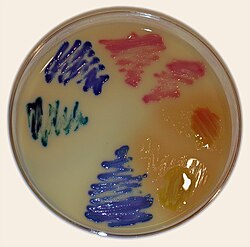
Differential or indicator media distinguish i microorganism type from another growing on the aforementioned medium.[9] This type of media uses the biochemical characteristics of a microorganism growing in the presence of specific nutrients or indicators (such as neutral carmine, phenol red, eosin y, or methylene blue) added to the medium to visibly betoken the defining characteristics of a microorganism. These media are used for the detection of microorganisms and by molecular biologists to detect recombinant strains of bacteria.
Examples of differential media:
- Blood agar (used in strep tests) contains bovine middle claret that becomes transparent in the presence of β-hemolytic organisms such as Streptococcus pyogenes and Staphylococcus aureus.
- Eosin methylene blue is differential for lactose fermentation.
- Granada medium is selective and differential for Streptococcus agalactiae (grouping B streptococcus) which grows as distinctive red colonies in this medium.
- MacConkey agar is differential for lactose fermentation.
- Mannitol salt agar is differential for mannitol fermentation.
- Ten-gal plates are differential for lac operon mutants.
Transport media [edit]
Transport media should fulfill these criteria:
- Temporary storage of specimens being transported to the laboratory for cultivation
- Maintain the viability of all organisms in the specimen without altering their concentration
- Contain but buffers and salt
- Lack of carbon, nitrogen, and organic growth factors so equally to prevent microbial multiplication
- Transport media used in the isolation of anaerobes must be free of molecular oxygen.
Examples of transport media:
- Thioglycolate broth is for strict anaerobes.
- Stuart ship medium is a non-nutrient soft agar gel containing a reducing agent to forbid oxidation, and charcoal to neutralize.
- Certain bacterial inhibitors are used for gonococci, and buffered glycerol saline for enteric bacilli.
- Venkataraman Ramakrishna (VR) medium is used for V. cholerae.
Enriched media [edit]
Enriched media contain the nutrients required to support the growth of a wide variety of organisms, including some of the more fastidious ones. They are commonly used to harvest as many unlike types of microbes every bit are present in the specimen. Blood agar is an enriched medium in which nutritionally rich whole claret supplements the basic nutrients. Chocolate agar is enriched with heat-treated claret (40–45 °C or 104–113 °F), which turns brown and gives the medium the color for which it is named.[ citation needed ]
Physiological relevance [edit]
The pick of civilisation medium might affect the physiological relevance of findings from tissue civilisation experiments, especially for metabolic studies.[10] In addition, the dependence of a cell line on a metabolic gene was shown to exist affected by the media blazon.[11] When performing a study involving several prison cell lines, utilizing a uniform culture media for all cell lines might reduce the bias in the generated datasets. Using a growth medium that better represents the physiological levels of nutrients can improve the physiological relevance of in vitro studies and recently such media types, as Plasmax[12] and human being plasma-like medium (HPLM),[13] were developed.
See besides [edit]
- Cell civilization
- Impedance microbiology
- Modified Chee'southward medium
References [edit]
- ^ a b c Madigan One thousand, Martinko J, eds. (2005). Brock Biological science of Microorganisms (11th ed.). Prentice Hall. ISBN0-13-144329-1.
- ^ Birgit Hadeler, Sirkka Scholz, Ralf Reski (1995). "Gelrite and agar differently influence cytokinin-sensitivity of a moss". Journal of Plant Physiology (146): 369–371.
{{cite periodical}}: CS1 maint: uses authors parameter (link) - ^ Ryan KJ, Ray CG, eds. (2004). Sherris Medical Microbiology (fourth ed.). McGraw Hill. ISBN0-8385-8529-9.
- ^ Hans Günter Schlegel (1993). General Microbiology. Cambridge University. p. 459. ISBN978-0-521-43980-0 . Retrieved 6 Baronial 2013.
- ^ Parija, Shubhash Chandra (1 Jan 2009). Textbook of Microbiology & Immunology. Elsevier Bharat. p. 45. ISBN978-81-312-2163-1 . Retrieved 6 August 2013.
- ^ Cooper, GM (2000). "Tools of Cell Biology". The Jail cell: A Molecular Approach . Washington, D.C: ASM Press. ISBN0-87893-106-6.
- ^ Catherine A. Ingraham, John Fifty. Ingraham (2000). Introduction to Microbiology.
- ^ Corry, Janet E. L.; Curtis, One thousand. D. W.; Baird, Rosamund M., eds. (1995-01-01). "Dichloran rose bengal chloramphenicol (DRBC) agar". Progress in Industrial Microbiology. Elsevier. 34: 303–305. doi:10.1016/s0079-6352(05)80036-0. ISBN9780444814982 . Retrieved 2020-04-twenty .
- ^ Washington, JA (1996). "Principles of Diagnosis". In Businesswoman, S; et al. (eds.). Businesswoman's Medical Microbiology (4th ed.). Univ of Texas Medical Branch. ISBN0-9631172-1-1.
- ^ Lagziel South, GottliebE, Shlomi T (2020). "Mind your media". Nature Metabolism. two (12): 1369–1372. doi:ten.1038/s42255-020-00299-y. PMID 33046912. S2CID 222319735.
{{cite journal}}: CS1 maint: multiple names: authors list (link) - ^ Lagziel S, Lee WD, Shlomi T (2019). "Inferring cancer dependencies on metabolic genes from large-calibration genetic screens". BMC Biology. 17 (i): 37. doi:10.1186/s12915-019-0654-4. PMC6489231. PMID 31039782.
{{cite periodical}}: CS1 maint: multiple names: authors listing (link) - ^ Vande Voorde J, Ackermann T, Pfetzer Due north, Sumpton D, Mackay Thou, Kalna G; et al. (2019). "Improving the metabolic fidelity of cancer models with a physiological cell culture medium". Science Advances. v (1): eaau7314. Bibcode:2019SciA....v.7314V. doi:x.1126/sciadv.aau7314. PMC6314821. PMID 30613774.
{{cite journal}}: CS1 maint: multiple names: authors list (link) - ^ Cantor JR, Abu-Remaileh Yard, Kanarek N, Freinkman E, Gao 10, Louissaint A; et al. (2017). "Physiologic Medium Rewires Cellular Metabolism and Reveals Uric Acid as an Endogenous Inhibitor of UMP Synthase". Cell. 169 (2): 258–272.e17. doi:10.1016/j.jail cell.2017.03.023. PMC5421364. PMID 28388410.
{{cite journal}}: CS1 maint: multiple names: authors list (link)
External links [edit]
- "The Nutrient Requirements of Cells"
Source: https://en.wikipedia.org/wiki/Growth_medium
0 Response to "How to Read Phenol Red Broth Test"
Postar um comentário